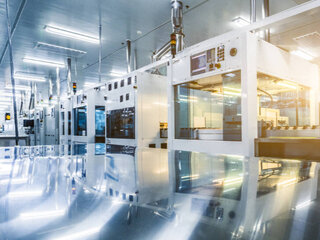Jetprinter – solder paste application without stencil
More flexibility in manufacturing thanks to jet printing
In electronics manufacturing, there are many ways to achieve the same goal. Some assemblies require high volumes, others require quick changes or frequent variations. Especially in the early stages of a project or for small series, it is often helpful to avoid using rigid tools. This is where the jet printer comes into play.
Jet printers were developed specifically for applying solder paste to printed circuit boards.
Unlike conventional SMD stencil printers, which use a physical stencil, a jet printer works with a digital print head, similar to an inkjet printer. This print head can apply the solder paste precisely and in a controlled manner to the desired locations on the printed circuit board.
How a jetprinter works
As already mentioned, a jet printer works in a similar way to an inkjet printer, but with highly viscous materials.
The print head moves over the circuit board and sprays the solder paste precisely onto the designated areas. The solder paste droplets are placed in the right quantity and in the right places, which enables a high degree of flexibility and precision. Control is fully digital, which means that physical stencils are no longer necessary. Changes to the design of the circuit board can be implemented quickly by adjusting the print data.
The jet printer can not only apply solder paste, but also set adhesive dots. These adhesive dots are used to fix SMD components to the underside of a circuit board. This is particularly necessary if the assembly is subsequently sent through wave soldering. Without this fixation, the components would slip or detach, as they are soldered from below in this process step. Thanks to the precise and freely programmable application of both paste and adhesive, the Jetprinter offers high process reliability and flexibility for a wide range of applications.
Technological details at a glance
- High precision: The jetprinter operates at a resolution of up to 100 μm, making paste printing suitable for the finest pad structures. Even for components such as 0201 or µBGA.
- Small paste volumes: The print head can precisely place drops in the range of just a few nanoliters. This also enables finely metered application to the smallest or closely spaced pads.
- Variable dot sizes: The drop size can be controlled by software, allowing different amounts of solder paste to be applied depending on the pad size or thermal management.
- Highly viscous materials: The printing process is specially designed for thick media such as solder pastes. Multiple prints per pad are also possible, e.g. to achieve higher build-up thicknesses.
- CAD-based workflow: The print data is generated directly from the layout data (ODB++, etc.). Manual intervention or special format adjustments are not necessary.
Advantages:
- Flexibility: Since no stencil is required, design changes can be implemented quickly and cost-effectively. This is particularly advantageous for prototypes or small series.
- Cost savings: There is no need to manufacture and store stencils, which reduces production costs.
- Precision for small quantities: The jet printer can apply very fine lines and small amounts of solder paste, which is advantageous for small series or prototypes.
- Quick changeover: Changing the design is easy and does not require any physical changes to the machine.
Disadvantages:
- Speed: Compared to stencil printers, jetprinters can be slower when printing large quantities, as applying individual droplets takes more time.
- Complexity: For very large production runs, stencil printers are more efficient and cost-effective.
- Print quality: Although precision is high, the quality of solder paste application with jet printers can sometimes vary, especially with very fine lines or special pastes.
- Acquisition costs: Sophisticated jetprinters can be more expensive to purchase than conventional stencil printers.
In summary, jetprinter is a flexible and modern solution for solder paste application, especially for small series, prototypes, or design changes. For large production volumes, classic stencil printers are often still the more economical choice. It therefore always depends on the specific requirements of the project.
Why we rely on the Jetprinter
Our customers also start new designs with prototypes and small series. Changes are not unusual at this stage. With the help of the Jetprinter, we save our customers the expense of purchasing new SMD stencils every time their designs change. The flexibility of the Jetprinter represents significant added value for our customers.
We also use the Jetprinter wherever different amounts of paste are required on individual pads on a circuit board. Instead of expensive stepped stencils, we jet the additional paste required with pinpoint accuracy. This is also a cost advantage for our customers.
If additional adhesive dots are required on the circuit boards, our Jetprinter also takes care of this work.
The jet printer has become an indispensable part of our SMT production. It can be easily integrated into production and ideally complements other processes.
This saves us time, avoids unnecessary downtime, and increases the flexibility of our manufacturing processes, which is a clear advantage for agile projects and frequent design adjustments.
As a customer, you benefit from a consistent, digital workflow.
Ready to get started? We are ready.
Whether for development, prototyping, or small series production, the Jetprinter makes many work steps easier and faster. If you are planning a project and want to see results early on, contactless paste printing is often the right solution.
Contact us. We will be happy to advise you.







